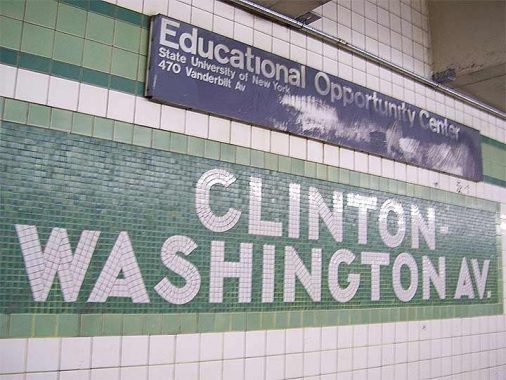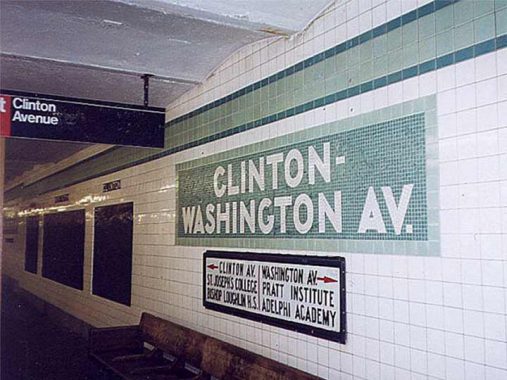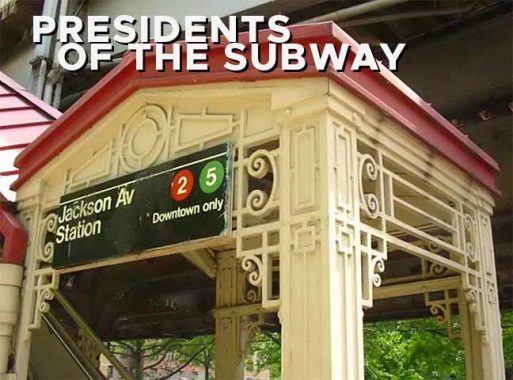
In 2019, FNY ran a piece about the Presidents of the United States whose names are represented in street names … whether the streets were named for former presidents or not. In fact, many of them were. This time, I have decided to run a piece about the names of the Presidents of the United States represented in subway station names. And, I’ll get this out of the way immediately: President Street itself, which runs through Park Slope and Crown Heights, is itself a stop on the #2/5 train, unusually built as an express station even though it sees only local service. Hey, Andy Sparberg, can you explain this anomaly?
All photos on this page appeared first in NYCsubway.org.




Oddly enough there are two separate Clinton-Washington avenue stations on IND lines in Brooklyn, one belonging to the Crosstown (G) and one a local stop on the Fulton Street line (C). Interestingly both bear green tile jobs; while most of the G line is tiled in green, only the local stations on the Fulton line between Hoyt-Schermerhorn and Nostrand Avenue get green.
Without a doubt, Washington is the most numerous street name among former presidents in NYC. As a military commander, he spearheaded the defeat of the British in the Revolutionary War, sealing American independence, and resisted entreaties to become a monarch, instead becoming the first head of America’s Executive Branch of governmental power.
No street named Clinton in NYC is of course named for Bill Clinton; you may have to go to Arkansas to find any. All Clinton streets in NYC are named for DeWitt Clinton, who held every possible major office in New York State and served as NYC mayor, and aspired to the presidency but didn’t get there.
Democrat Grover Cleveland (who moved to New York State from New Jersey as a young man and served as mayor of Buffalo and NYS governor) holds the distinction of being the only president to be defeated for a second term and run again in the next election and win the rematch, becoming the only president to serve two nonconsecutive terms. He lost to Benjamin Harrison in 1888 and then defeated Harrison in 1892. The Statue of Liberty was dedicated during his first term in 1886.
Why Grover Cleveland got a street in East New York, well, I’ve never been afraid to admit, I dunno. {an answer has been found; see comments]
Grant Avenue is the last underground station as you travel east on the A/C train as A’s proceed either to Ozone Park or the Rockaways. It’s a relatively new station constructed in 1956 when the IND was connected to the east end of the Fulton El.
The avenue is indeed named for Ulysses S Grant, as a number of streets in Cypress Hills are named for Civil War figures such as Lincoln, Grant and Sheridan. While Abraham Lincoln was elected a second time, Ulysses S Grant was the first president to serve two full terms since Andrew Jackson, himself a wartime general who became president. He was the first of two presidents whose middle initial, S, was just an initial and didn’t stand for a name. Historians assert that Grant, who had alcoholic woes, was a less effective president that he was a military leader. Grant was in a run of 7 straight presidents with facial hair of some kind; Lincoln was the first to wear a beard, while Samuel Tilden would have broken the streak had he prevailed against Hayes.
Two subway stations are named Jackson Avenue and neither is named for a President. While Jackson Avenue in Port Morris was named for landowner Washington Jackson in 1905…
…Vernon-Jackson Avenue remembers a 19th-century developer named John Jackson, who built a toll road in Queens that was named for him. At its western end it kept the Jackson Avenue name but east of Queens Boulevard, it lost its tollgates upon Queens’ admittance into Greater New York and became Northern Boulevard.
“Old Hickory” can definitely count Manhattan’s Jackson Street in the Lower East Side in his ledger.
Oddly enough Abraham Lincoln’s name did not appear on any NYC subway signs save the Lincoln Road exit of the Q train at Prospect Park until 1990s station renovations of the 66th Street station added “Lincoln Center” to the signage. Until Robert Moses built Lincoln Center in 1959 the crossroads of Columbus Avenue and Broadway was called Lincoln Square.
The Flushing Line preserves some ancient street names in station signage. If the long-awaited 52nd Street station renovation ever takes place, I’m not sure if its 52 St-Lincoln Avenue signs will survive. 52nd Street hasn’t been called Lincoln Avenue since about 1920 or so. Photo from the excellent Subway Nut.
New York City was a bastion of Confederate supporters, writes author John Strausbaugh in his book, “City of Sedition,” and was comprised of only the island of Manhattan during that era. Perhaps it is unsurprising, then, that only a few official locales in Manhattan were named for the Illinois Railsplitter, including Lincoln Center at Broadway and Columbus Circle, which was originally Lincoln Square; and the uptown Lincoln Houses, where Park Avenue meets FDR Drive. Abraham Lincoln kicked off his 1860 campaign for president in a speech at then-new Cooper Union, at Third Avenue and Astor Place, and local lore has it that afterward, he had a drink at nearby McSorley’s on East 7th Street.
Teddy Roosevelt got himself a subway station when the IND was built out through Queens in the 1930s. Roosevelt Avenue itself was built in the early 1910s as the Corona Elevated was constructed, and when it was extended east to Flushing in 1928, the city switched Amity Street to Roosevelt Avenue.
One of the more storied presidents in history, Theodore Roosevelt was a warrior, explorer, reformer, governor and president, ascending to the White House after William McKinley’s assassination and winning election outright in 1904. He ran again under his own Bull Moose Party banner in 1912, but split the vote with his Republican successor William H. Taft, allowing Democrat Woodrow Wilson the presidency. As he was giving a speech in 1912, he was shot in the chest by a would-be assassin. He finished the speech.
Sorry, folks, my subway bullet collection is old and I don’t have any orange M’s.
Franklin D. Roosevelt has had a station all his own since 1989, when the Roosevelt Island station, one of the deepest stations in the system requiring three escalator tiers to get to the bottom or top. Originally called a Native American term, the cigar-shaped island in the East River has gone through three names in English: Blackwell’s, Welfare and since 1972, Roosevelt Island. A park bearing a bust of the pride of Hyde Park opened in the 2010s after decades in the planning stages.
FDR is considered a titan of the 20th Century, assuaging the Great Depression (1929-1941) and overseeing the USA’s entry into World War II after the Japanese surprise attack on Pearl Harbor in December 1941. He approved the D-Day invasion of German-controlled France in June 1942. By his death in 1945 WWII was all but won, but his conference at Yalta with Winston Churchill and Joseph Stalin had set the stage for a longer conflict, the Cold War with the USSR and other Communist countries that continued until the USSR’s collapse in 1990 (Hostilities with Russia seem to be resuming at this writing.). Under Roosevelt, the USA became a true world power. He was the only president elected 4 times, as he continued to run for the presidency while the USA was embroiled in the war. No president since has run more than two times. He did it all from a wheelchair, as he was afflicted with polio as a youth.
Some of the best and most colorful subway mosaics can be found on the BMT Canarsie Line, built from 1924-1928 from 6th Avenue to East New York. Wilson Avenue is the only split-level subway station that has one platform outdoors and one indoors, and arrangement necessitated by the proximity of Evergreens Cemetery and its graves.
Despite the 1915 sinking of the Lusitania steamship liner and other German provocations, Woodrow Wilson campaigned for reelection in 1916 with the slogan “he kept us out of war.” By 1917, though, things were going so badly in Europe that America could be sidelined no longer and we went “over there.” Prohibition (of alcoholic beverages) was instituted under the Volstead Act in 1919.
The USA declared war on Germany April 6, 1917, after German submarines attacked several American merchant ships. Thus the USA entered the Great War, and this had an effect on the map of Brooklyn…
A few Brooklyn street names, it was decided, had to change if they named for German place names. Thus, Dresden Street in Arlington became Highland Place, Bremen Street in Bushwick became Stanwix, and Siegel Street, named for a German-born Union Civil War general, Franz Sigel, gained an extra “e”, perhaps to camouflage a German spelling. Most famously, though, Hamburg Avenue was renamed for the sitting president and became Wilson Avenue.
As always, “comment…as you see fit.” I earn a small payment when you click on any ad on the site.
2/21/22
